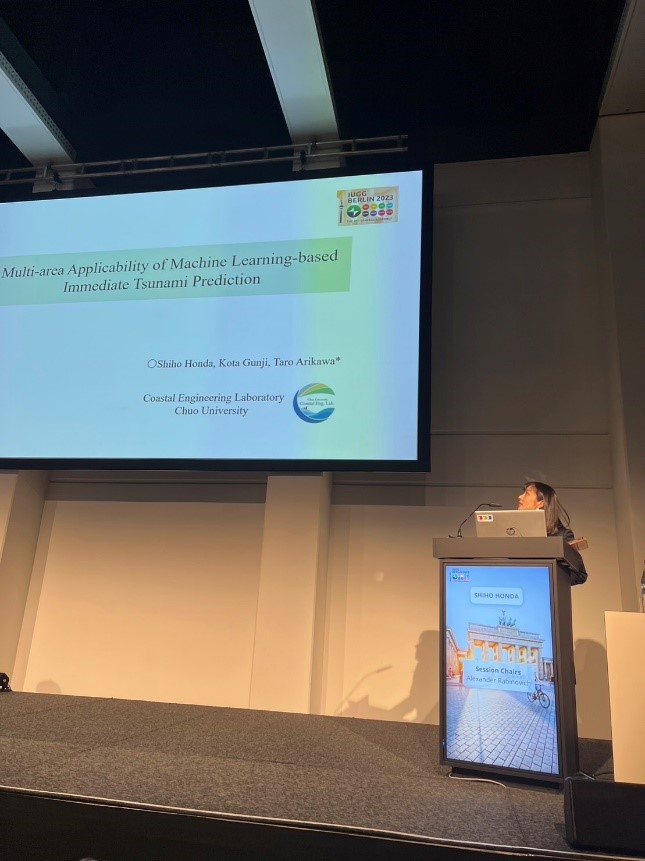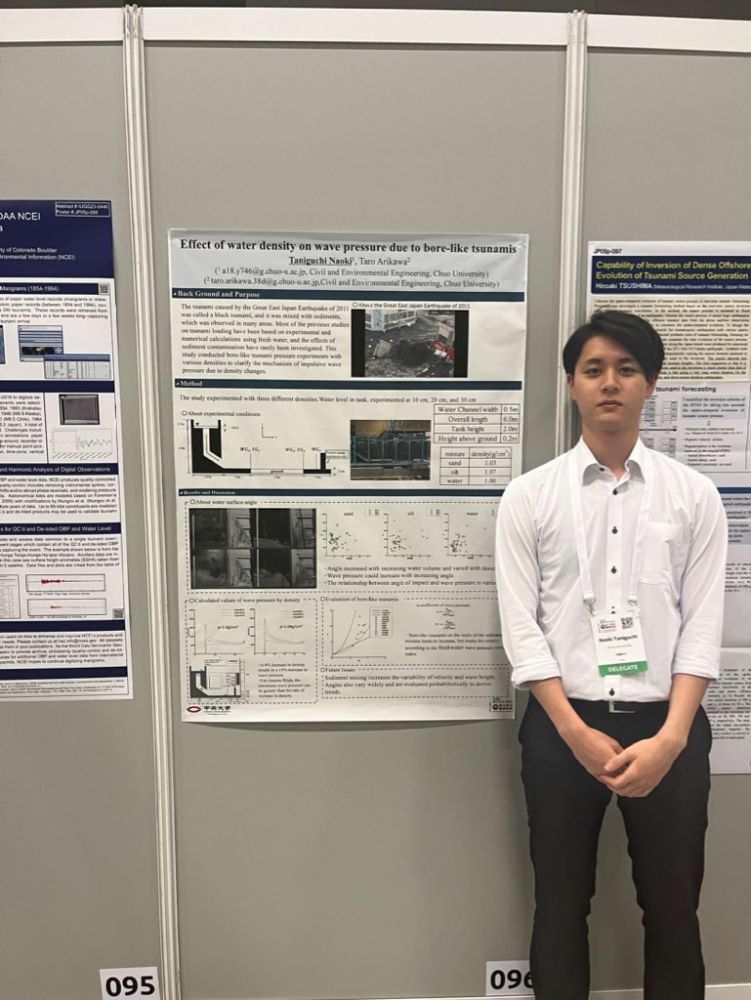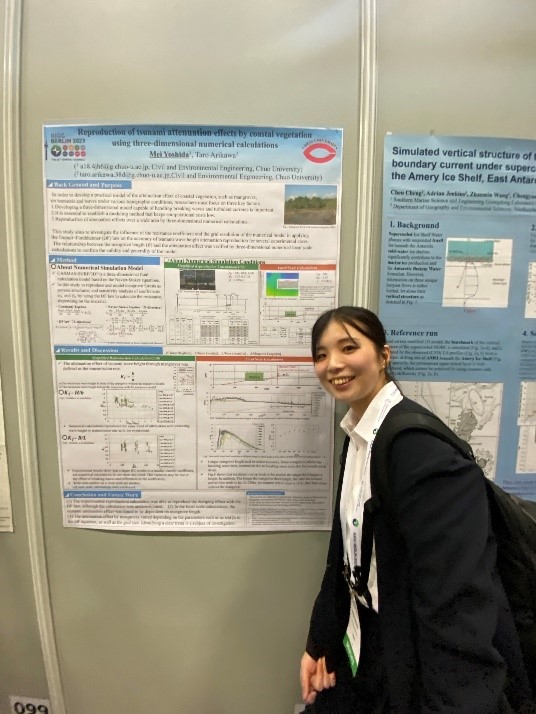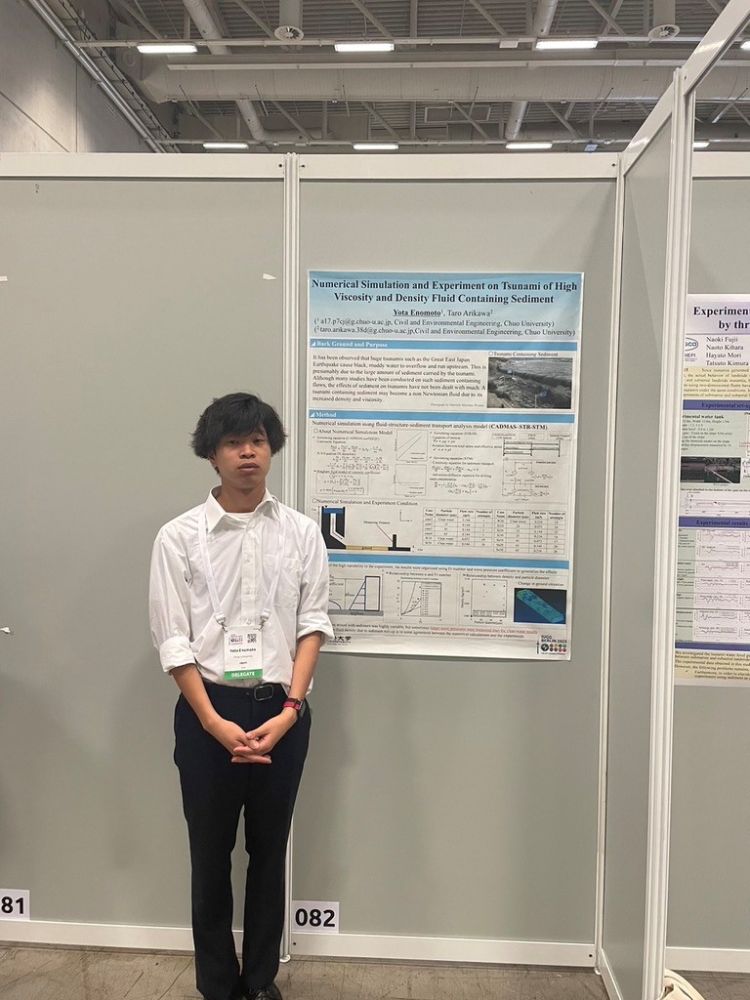2023.09.20
News
4 Students from Department of Civil and Environmental Engineering belonging to Arikawa Lab. gave presentations at the 28th general assembly of the IUGG in Berlin
In July, 2023, 4 Students from Department of Civil and Environmental Engineering belonging to Arikawa Lab., gave presentations at the 28th general assembly of the International Union of Geodesyand Geophysics in Berlin.
【M2】Shiho Honda (Oral Presentation)(Abstract Peer-Reviewed)
Presentation Title: Multi-area Applicability of Machine Learning-based Immediate Tsunami Prediction
Author: Shiho HONDA, Kota GUNJI, Taro ARIKAWA
Abstract: In light of potential massive tsunamis, such as those from the Nankai Trough earthquakes, real-time tsunami prediction is becoming crucial for evacuation planning. While machine learning is one of the methods used for immediate tsunami prediction, not many studies have focused on predicting the tsunami arrival time. In this research, thousands of tsunamis were simulated for three different earthquake magnitudes. The aim was to predict tsunami arrival times using machine learning and examine the errors across multiple regions. Results revealed that in coastal areas with frequent tsunami occurrences, errors tend to be larger. It was also found that if the error is doubled in a target area, more than double the learning data might be needed to make the same prediction accuracy.
【D1】Yota Enomoto (Poster Presentation)(Abstract Peer-Reviewed)
Presentation Title: Numerical Simulation and Experiment on Tsunami of High Viscosity and Density Fluid Containing Sediment
Author: Yota ENOMOTO, Taro ARIKAWA
Abstract: The potential for tsunamis to pick up sediment from the seabed and coastline, and the subsequent effects this may have on wave behavior, might increase the wave force. This study aimed to deepen our understanding of this phenomenon and quantitatively assess its impact. The focus was on changes in fluid density and viscosity when sediment mixes with a tsunami. The study was conducted using numerical simulations and hydrodynamic model experiments. The results indicated that especially the sustained wave pressure tends to increase due to changes in fluid density and viscosity.
【M2】Naoki Taniguchi (Poster Presentation)(Abstract Peer-Reviewed)
Presentation Title: Effect of Water Density on Wave Pressure Due to Bore-like Tsunamis
Author: Naoki TANIGUCHI, Taro ARIKAWA
Abstract: The tsunami generated by the 2011 Great East Japan Earthquake was termed the "Black Tsunami", where sediment mixing was observed in various locations. Most existing research on tsunami loads are based on experiments using freshwater and numerical calculations, with limited study on the effect of sediment mixing. In this research, bore-like tsunami wave pressure experiments were conducted using various density states to clarify the mechanism of impact wave pressure generation due to density changes. Numerical calculations were also performed to compare with the sediment uplift volume observed in the experiments.
【M2】Mei Yoshida (Poster Presentation)(Abstract Peer-Reviewed)
Presentation Title: Reproduction of Tsunami Attenuation Effects by Coastal Vegetation Using Three-Dimensional Numerical Calculations
Author: Mei YOSHIDA, Taro ARIKAWA
Abstract: The tsunami attenuation effects of coastal vegetation, such as mangroves, are widely known from field studies, and have been researched both experimentally and numerically. While extensive two-dimensional calculations have been conducted for wave attenuation effects, constructing a universal model applicable to various wave conditions, including the breaker zone, requires three-dimensional calculations. In this study, three-dimensional numerical calculations were performed using a numerical wave tank, focusing on modeling mangrove resistance calculations based on the Dupuit-Forchheimer equation. The study explored the reproducibility of tsunami attenuation effects. Reproduction calculations were conducted at both experimental and field scales, revealing the relationship between the wave height to water depth ratio, the width offshore of the mangroves, and their attenuation effects.
To learn more click below;

【M2】Shiho Honda

【M2】Naoki Taniguchi

【M2】Mei Yoshida

【D1】Yota Enomoto
